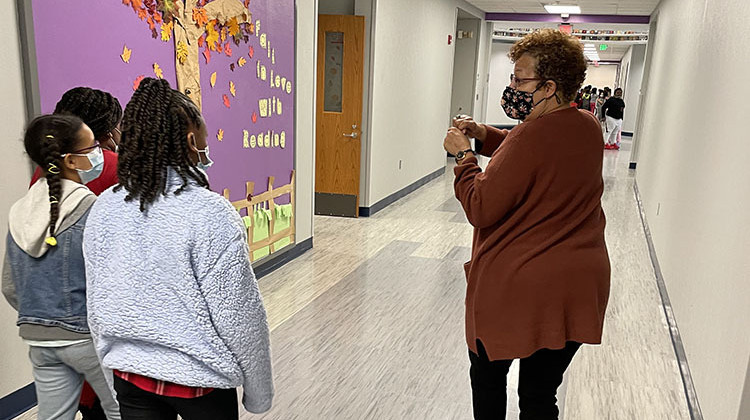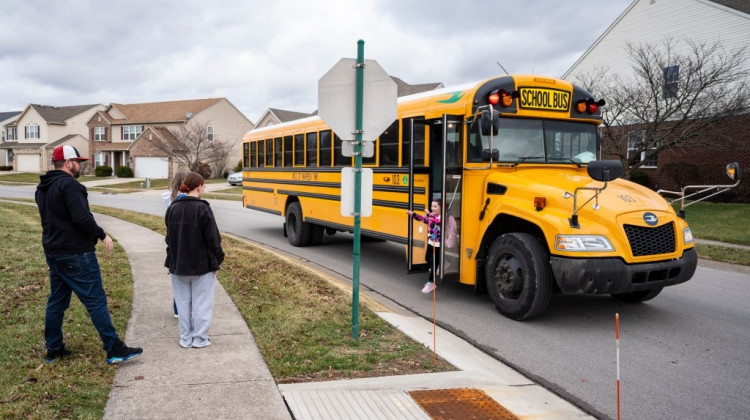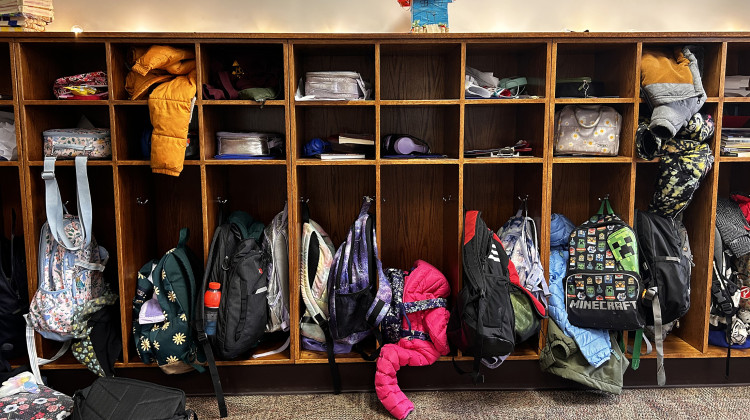
CIS Indiana site coordinator Shelia Richardson walks down a hallway with students at Winding Ridge Elementary in the MSD of Lawrence Township School district.
(Submitted photo)
Students who struggle to have their basic needs met may also face challenges when meeting their academic goals. But the national organization Communities in Schools has been trying to help schools meet students’ entire needs. CIS of Indiana currently works with 26,000 K-12 students in Indianapolis, Lawrence Township, Decatur Township, Bloomington, Lafayette, Randolph County, Lake County and Wayne County to help support underserved students.
The organization connects schools with one or two site coordinators who help students and families find resources. Now CIS of Indiana plans to expand their efforts after it recently received an $800,000 donation from philanthropist MacKenzie Scott. It’s the largest donation in the organization's history.
WFYI’s Elizabeth Gabriel interviewed CIS of Indiana Executive Director Hadley Moore Vlahogeorge about the organization and how it plans to spend the money. This interview has been condensed and edited for clarity.
Elizabeth Gabriel: Communities in Schools is a national organization aimed at helping students meet their non-academic needs in order to be successful in school. Can you share how long the program has been in Indiana and what your model is?
Hadley Moore Vlahogeorge: So the program has actually been in Indiana in various [incarnations] since the 1980s. And we have two longtime affiliates working in our state – CIS of Lake County and CIS of Wayne County. And both of those preceded the state office in their formation and their work. The state office was formed about nine years ago – CIS of Indiana – in order to expand our model to more schools and more communities. So we're sort of the expansion arm of the organization statewide.
The CIS model is unique because it begins with a school needs assessment. A site coordinator really delves into the data. They interview students, parents, faculty members, administration and community members. And they identify where the gaps are in services for students. So that first of all, they don't duplicate anything that's already being done in schools. But secondly, they let that data inform what their roadmap is to bringing more resources, bringing more programming, creating more opportunities and providing intensive student supports for kids.
We have three tiers of interventions. Our tier one interventions are for the entire school building. So that could be a financial aid information night at the high school level, maybe a 21st Century Scholars session at the middle school or a parenting and Zumba class in elementary school. Our tier two interventions are more targeted, and those are usually done in small groups. And those tend to focus on culture and climate issues in the school, and some social skills or employability skills. And then our tier three interventions are targeted interventions for individual students, and those students are case managed. And so in order for the needle to really move for those students, not only do they need someone who's constantly evaluating the effectiveness of these interventions, but they need a very trusted adult to build a relationship with that child and build a relationship with that child's family. Because family engagement is a really key part of the case management piece, and working together to remove barriers to access of any social services or resources that a family can need is really imperative in that tier three.
Gabriel: You all have recently expanded to serve roughly 26,000 students across 31 schools. Can you provide some examples of how the program has helped students?
Vlahogeorge: Absolutely. One of probably our favorite stories to tell is the story of a middle school student who came to a new school. He was really struggling to adjust. He struggled significantly in terms of behavior, in terms of attendance. And so working with a site coordinator and being given goals to accomplish – again, I mentioned that data is a major piece in what we do. And so as we provide interventions to this student, we are able to progress monitor and track the impact that those interventions have. Not only did he improve his academic performance, his behavior and his attendance, but due to the case managed services, a relationship was built with that student's mom.
And because things were difficult at home, that was one of the reasons why he was acting out in school. And so being able to connect them to first of all their basic resources – like some rent assistance, like a regular food pantry and medical care and services. We were also able to get mom hooked up with a local charter school to earn her high school diploma. And so she was enrolled, she got her high school diploma, she was able to get a better job and then she was able to find significantly more stable housing. And so that student was able to stay in school, was able to meet his goals that we set for him in the case management, but then mom's life was impacted as well. And she was able to continue to support her family and improve life for everyone in that household, all because of one site coordinator connecting and working with them.
So that's ideally what we want to see. We don't just throw granola bars at the problem and assume that it's fixed. We get to know our students, we get to know their families and we get really creative about problem-solving what resources they need and bring them directly to them.
Gabriel: Philanthropist MacKenzie Scott has pledged to give away most of her billions in wealth to charity. She gave nearly $134 million to the national Communities in Schools organization. You will receive $800,000 for Indiana. What do you think attracted Scott to support this work?
Vlahogeorge: So Mackenzie Scott does her due diligence. And so she researched the national organization. But more importantly, she researched each of the organization's affiliates. So she chose CIS of Indiana to give $800,000. And she did not have to give us that fund. She could have simply just given to the national office and let them expand it. So she recognizes the work that we're doing in the state of Indiana.
The CIS model really stems from a larger belief that it takes a village to raise a child. And in Indianapolis especially, we have so many community resources – we have so many organizations, we have so many philanthropies, so many charities, so many nonprofits – and they want to help kids. Oftentimes, it's just hard to get access and to strategically implement how to best utilize all the many resources that our community has. And so the great thing about Communities in Schools of Indiana is that site coordinator recognizes and learns what each individual building needs. And then they bring the resources directly to that building. So then parents and students don't have to struggle to access what they're looking for or what they need to be successful. And so MacKenzie Scott knows that this is just one of many ways to support children. But it's an effective way of supporting children. And the need in our country, the need in our state for our young people has never been greater.
Gabriel: And how do y'all plan to use the money to support students?
Vlahogeorge: That is kind of the question of the day. One of the things that attracted me to Communities in Schools of Indiana is the incredible board of directors that it has. Not only are there multiple current sitting superintendents on there, like Dr. Shawn Smith in Lawrence Township, Dr. Matt Prusiecki in Decatur Township, Dr. Kyle Barrentine in Nettle Creek School System. But there are many career educators that are also on there. Most notably Dr. Suellen Reed who was a former Indiana State Superintendent of Public Instruction. And so they know exactly what is happening in school buildings today. And they know exactly what kids need. And so our plan for the money will be determined by them. And I have full faith in their abilities to identify what would be the most impactful way of spending it.
What I can tell you is undoubtedly some of it will be spent on expansion. And so we're thinking really strategically about how we can expand responsibly, sustainably and long-term. Because when a CIS site coordinator is placed in a building, they're making a commitment to that community, they're making a commitment to those kids and the last thing we'd want would be to have to leave because money has run out. And so we want to be very responsible, very prudent and very thoughtful with the funds.
Contact WFYI education reporter Elizabeth Gabriel at egabriel@wfyi.org. Follow on Twitter: @_elizabethgabs.
 DONATE
DONATE






 Support WFYI. We can't do it without you.
Support WFYI. We can't do it without you.